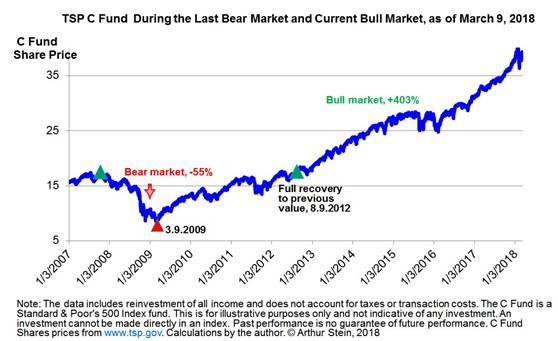
Happy birthday bull market, now what?
Senior Correspondent Mike Causey examines why feds sometimes have to tighten their belts for the first few months of retirement.
One of the longest running bull markets in history is celebrating its ninth birthday this month. Nine — that’s long ago enough that some of us have forgotten the Great Recession that preceded this robust, long-running baby bull.
Some, on the other hand, remember it all too well. And many who retreated from the stock-indexed funds into the “safety” of the treasury securities G fund missed out on some, or all, of the dramatic rise in stocks.
We asked Arthur Stein, CFP, of Arthur Stein Financial LLC in Bethesda, Maryland, to comment on the bull market and what comes next. Many of his clients are federal workers or retirees and few are even self-made TSP millionaires. So what’s his message: “Well, happy birthday to the bull market, now nine years old. Blow out the candles, cut the cake, let’s enjoy it while we can.”
“Bull market” and “bear market” are common financial terms. A bull market is a 20 percent or greater gain from a previous stock market low. A bear market is a 20 percent or greater loss from a previous stock market high.
The table below illustrates the previous bear market and current bull market. Both events represent records.
The 2007-2009 bear market was the worst since the end of World War II, with stock markets down 57 percent from previous highs. Full recovery for the C fund did not occur until Aug. 9, 2012.
The current bear market is the second longest in US history and still going. If it continues through August of this year, it will be the longest. The Share price for C fund increased five times from the low point.
How should you celebrate the bull market’s ninth birthday? Instead stead of sending presents, do:
- Review your portfolio. Because of the large increases in stock market returns (compared to bonds), your percentage allocation to the TSP stock funds (C, S and I) may be higher than your goal. If so, reallocate some of your stock fund investments to bonds (F and G Funds).
- Prepare mentally. Bear markets are normal – but unpleasant – events. Historically, bear markets occurred every 3 and a half years, on average. It has now been nine years since the last bear market, so another bear market is long overdue. If you know a bear market is coming, it may not seem so scary when it arrives.
- Prepare financially.
- Review current balances in the TSP funds. What is your current goal and bear market strategy? Possible strategies include riding it out, leaving funds currently allocated to the stock funds and not making any changes when the bear market occurs.
- React to the bear market. After it occurs, move money from the bond funds to the stock funds to return to your stock/bond allocation goal.
- Try to time the markets (although not suggested by this author). Transfer from the stock funds to the bond funds when you think stock markets have peaked. Reinvest when you think the market is at or near the bottom.
- Still working?: Review the allocation of your bi-weekly contributions to the TSP. The contribution percentages don’t have to be the same as the allocation of your current account balance.
- Retired?: If you need to withdraw funds from investments for living expenses or Required Minimum Distributions, now — when the market is still doing well — might be a good time to sell some stock funds to generate the cash. Remember, this strategy is difficult with the TSP because withdrawals must be proportionate to your current fund allocations.
- Try to increase the amounts you have in bank accounts outside the TSP to minimize the need to sell investments. It is possible for the bond market and stock market to decline at the same time. That would be a good time to use your bank accounts.
“ Remember, parties don’t last forever. And past performance is no guarantee of future performance.” Arthur Stein Art@ArthurSteinFinancial.com
Nearly Useless Factoid
By Amelia Brust
Despite its reputation in American popular culture as a rural pastime, cow tipping is not only rare but nearly impossible to accomplish. Dairy cows can weigh as many as 1,200 to 1,400 pounds, they do not always sleep standing up, and they are naturally wary animals. If a friend claims to have tipped a cow in their lifetime, or to know someone who has, it is more likely bull.
Source: Modern Farmer, The Harvard Crimson
Copyright © 2025 Federal News Network. All rights reserved. This website is not intended for users located within the European Economic Area.
Mike Causey is senior correspondent for Federal News Network and writes his daily Federal Report column on federal employees’ pay, benefits and retirement.
Follow @mcauseyWFED





